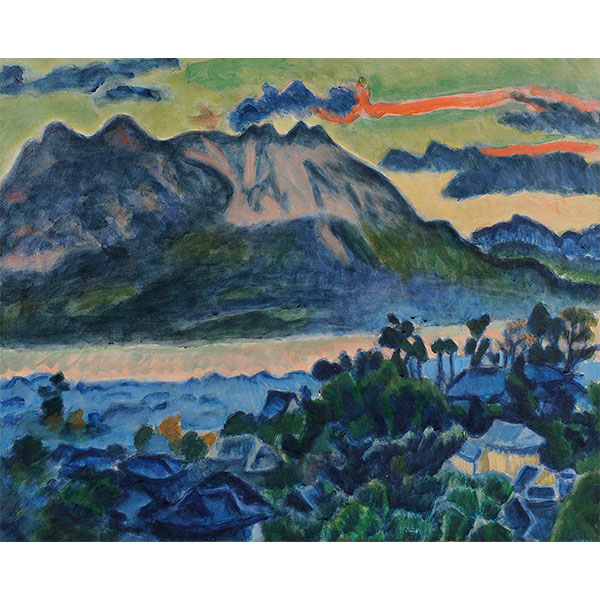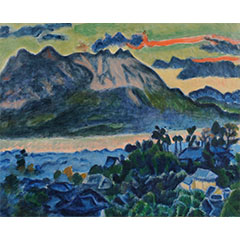
動画による作品解説
梅原龍三郎
朝暉
1937(昭和12)年 64.6×79.5cm
Ryuzaburo Umehara
Morning Glow
1937 (Showa 12), 64.6 × 79.5 cm
まだ夜が残る群青色の街並みの向こうに、太陽の光を受けて浮かび上がる桜島のすがた。錦江湾には鈍い光が満ち、遠くの空も仄かに明るんできています。木々の緑はうっすらとした光を受け、街には間もなく朝が訪れるようです。わずかに赤みを帯びながら闇から姿をあらわす桜島の威容は、人々が生活する時間の感覚を超越した大地の息吹が感じられます。
梅原龍三郎(1888-1986年)は20歳のときにパリに留学してルノワールに師事、滞欧中にはイタリアのナポリを訪ねました。そのときのことを「この辺の海は、大気か何かの関係で色が素晴らしく美しく好きだった。だから山手の街など歩きながら、人がいないと踊り出したいくらい、美しいと思った事がある」とその感激を述べています。そして1921(大正10)年、師ルノワールの弔問のため南仏を訪れた際、再びナポリを訪ねました。噴煙を上げるヴェスヴィオ山の近くで偶然出会った日本人に梅原は「此この美感に桜島の景色が似てゐる」と聞き、その言葉が心に深く残りました。そして13年後、梅原は東京でふと耳にした鹿児島の民謡・小原節を聞いて「長閑な南国の景色が夢みられ、矢も楯もたまらず行て見度なり腰を上げた」といいます。それは1934(昭和9)年1月のことでした。東京から汽車で20時間以上揺られて初めての九州の旅、梅原の高揚する気持ちが想像されます。
鹿児島では友人の柳宗悦が紹介した人物の案内により岩崎谷荘に宿泊します。鹿児島の中央に位置する城山の麓にあるこの宿は「錦帆湾(原文ママ)上に幻の如く浮ぶ桜島の全貌を眺める家」であり、梅原が桜島を描くには絶好の場所でした。その座敷からは「城山を右に眺め山の尾の海に消える辺から桜島が空高くすまひ海が帯のように腰を巻いてゐる」という壮大な眺めが広がります。そして、その風景は梅原にナポリでの体験を喚起しました。「此パノラマが誠にベスビオとソレント半島を一眸に見るナポリの景色にも匹敵する風光である。東に面する桜島は朝青く夕は燃える樣に赤い、噴煙は時に濃く時に淡い、朝など濃藍の空と山の間に白く見える事もある。空の色海の色緑の色の光り強く美しき事我國内地此処に匹敵する処を自分は未だに知らない」。その壮麗な大地の美しさを梅原はそう謳っています。以後6年の間、梅原は毎年、鹿児島を訪れては桜島を描きました。桜島に訪れる暁の鈍い暉きを捉えた《朝暉》には、地球が巡る大自然の営みさえ感じられるようです。
Beyond the indigo-colored cityscape, still cloaked in night, the figure of Sakurajima emerges, illuminated by the sunlight. Kinko Bay is filled with a dull light, and the distant sky is faintly brightening. The greenery of the trees is faintly lit, and it seems that morning will soon arrive in the city. The majestic figure of Sakurajima, tinged with a slight red hue as it emerges from the darkness, conveys the breath of the earth, transcending the sense of time in which people live.
Ryuzaburo Umehara (1888-1986) studied under Renoir in Paris at the age of 20 and visited Naples, Italy, during his stay in Europe. He expressed his admiration, saying, "The sea around here was wonderfully beautiful due to the atmosphere or something, and I loved it. So much so that while walking through the hillside towns, I felt like dancing when no one was around because it was so beautiful." In 1921, he visited Naples again while staying in southern France to pay respects to his late teacher Renoir. There, he met a Japanese person near Mount Vesuvius, who told him, "The beauty of this scenery resembles that of Sakurajima," and those words deeply resonated with him. Thirteen years later, Umehara heard the Kagoshima folk song "Obara-bushi" in Tokyo and said, "The idyllic scenery of the southern country appeared in my dreams, and I couldn't resist the urge to go and see it." This was in January 1934. It was his first trip to Kyushu, swaying on a train for over 20 hours from Tokyo, and one can imagine Umehara's excitement.
In Kagoshima, he stayed at Iwasakidani Villa, guided by a person introduced by his friend Yanagi Muneyoshi. This inn, located at the foot of Shiroyama in central Kagoshima, was "a house where you can view the entire Sakurajima floating like a phantom on Kinko Bay." It was an ideal place for Umehara to paint Sakurajima. From the tatami room, there was a magnificent view of "Sakurajima rising high in the sky from the area where the mountain ridge disappears into the sea, with the sea wrapping around it like a belt." This scenery evoked his experiences in Naples. "This panorama truly matches the scenery of Naples, where you can see Mount Vesuvius and the Sorrento Peninsula in one glance. Facing east, Sakurajima is blue in the morning and red like it's burning in the evening. The smoke is sometimes thick, sometimes thin, and in the morning, it can appear white between the dark blue sky and the mountain. The colors of the sky, sea, and greenery are strong and beautiful. I have never known a place in Japan that matches this." Umehara praised the magnificent beauty of the land. For the next six years, Umehara visited Kagoshima every year to paint Sakurajima. In "Morning Glow," which captures the dull glow of dawn over Sakurajima, one can feel the workings of the great nature of the earth.

